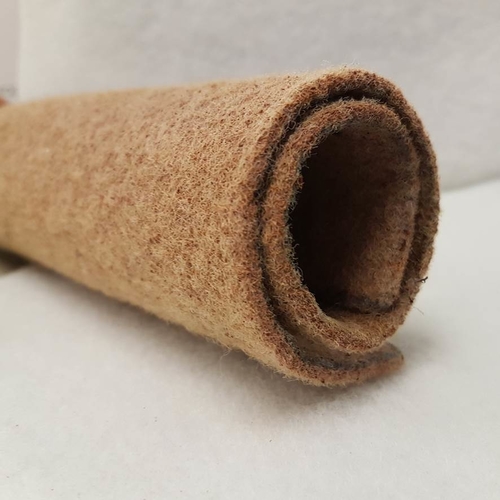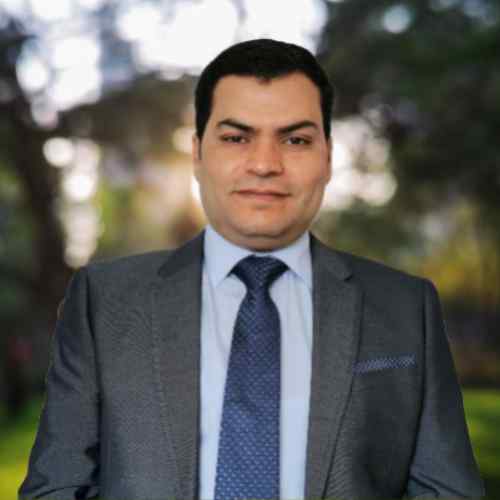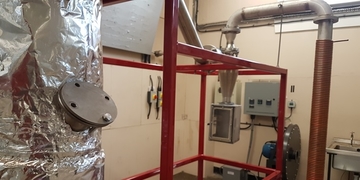
Dr David Bryce, Research Associate, Laboratory Manager
Research Biography
David’s PhD research focused on fundamental research of the composite interphase region, a key parameter in composite material performance. This work investigated the effects of fibre sizing and processing parameters and was funded by wind turbine manufacturer Suzlon. Other areas of research interest include sizing performance at high temperatures and polymer curing behaviour.
Current Project
David is currently working full time as part of a composite upcycling consortium comprised of the University of Strathclyde, Aker Offshore Wind, Cubis Systems, GRP Solutions and Composites UK. The project aims to push lab-scale composite recycling technology to the next stage of commercial implementation.
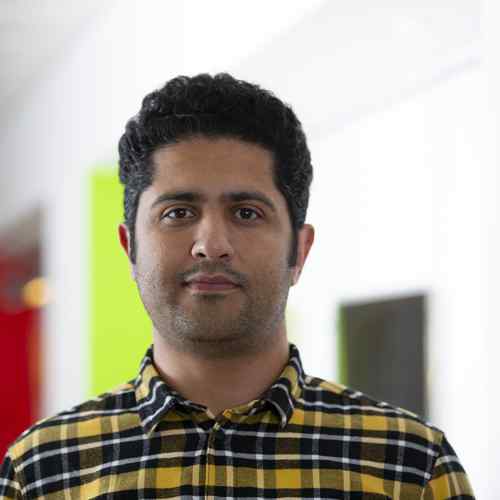
Dr Ramin Moradi, Research Associate
Research Biography
Ramin’s PhD investigated power generation from low-grade heat sources using micro-scale organic Rankine cycle (ORC) systems for waste heat recovery (WHR) and trigenerative (CCHP) applications. His research interests include waste recovery systems, such as heat, agro-industrial residues, municipal solid residues, and fibre-reinforced composite materials (FRCs). He also investigates the design and modelling of energy of systems and thermal processes.
Current Project
Ramin is currently working full-time as part of a composite upcycling consortium comprised of the University of Strathclyde, Aker Offshore Wind, Cubis Systems, GRP Solutions and Composites UK. The project aims to push lab-scale composite recycling technology to the next stage of commercial implementation.
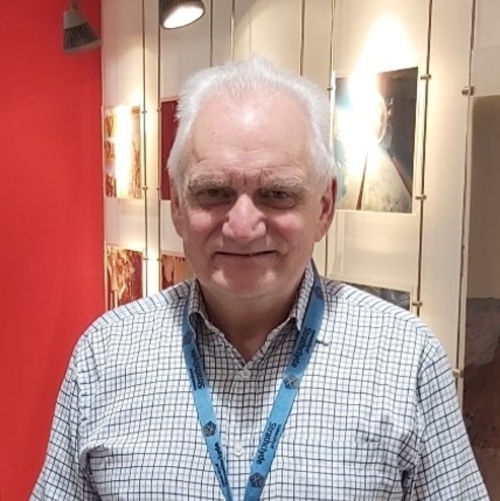
Chris Cameron, Laboratory manager / PhD student
Expertise
- Design, Manufacture and Analysis of laminar Fibre Reinforced Polymer structures.
- Material Selection and Manufacturing Protocols for Component Design.
Current Project
The optimal design of a light weight composite pressure vessel by use of cellular core sandwich structures
Project description
This research looks at the design and analysis of cellular core sandwich structures. These structures, in the form of plates and shells can give a much higher strength to weight ratio than their solid alternatives. The main aim of the work is to derive a theoretic protocol to analyse the efficiency of cellular core sandwich structures. A literature review of all relevant engineering theories will reveal the best stress calculation methodology to model the dominant stresses in flat plates and curved shells with cellular core sandwich structures. A finite element model will be constructed to allow visualisation of stress fields and corroboration of the results of the calculated stresses.
An experimental program will be designed and implemented. The first set of tests will be designed to find the basic material properties of the structures. The second testing program will be designed to test the plate and shell structures under pressure and will require a dedicated test rig.
The conclusion will bring theoretical, finite element and experimental results together, in order to determine the effectiveness of cellular core structures in light weight pressure vessel design.
Chris' background
After completing an engineering apprenticeship, Chris spent ten years in industry as a service engineer in the material testing and analysis. He graduated from the Open University with a BA in mathematics, before joining the University of Strathclyde in 1993 as a laboratory supervisor. Chris has since graduated from Strathclyde University with an MSc in Materials Engineering and has become the departmental laboratory manager. He has now embarked on a course of study towards a research PhD.

Sheik Abdul Malik, PhD student
Current Project
Composite manufacturing techniques with reduced cycle time and cost for automotive applications
Project description
Current part fabrication process is only good enough for low volume cars but for use in mass produced vehicles, there is a need for dramatic process improvisation. With the advent of electric cars & other mobility solutions to replace the traditional automobiles, the drive to achieve environmental & economic targets for all industry sectors is intense. The benefits of lightweight composite structures contribute to these targets. Hence it is imperative to have a feasible standardization process in place for composites manufacturing to be widely adopted in the industry.
Malik’s background:
Prior to beginning my PhD I gained experience at ACCIS, Bristol in Design for Manufacture of composites. I was responsible for developing Virtual Fabric Placement (VFP) simulation program designed for producing composite parts ‘right the first time’. Implementing the Industry 4.0 methodologies and integrating VFP with various available ICT platforms, the solution was validated and demonstrated to be useful in an industrial scale, thereby improving process efficiency and enabling a closed loop design and manufacturing cycle.
During time at Airbus I was involved in the A350 XWB winglets design and production team. Additionally, I was in charge of Long Range stress and 330 NEO programme.
I am in pursuit of a game changing idea and am hopeful that this PhD journey will help me get closer to this goal. I’m your go to man to chase a daring new innovation. Come find me if you are on the verge of a breakthrough.
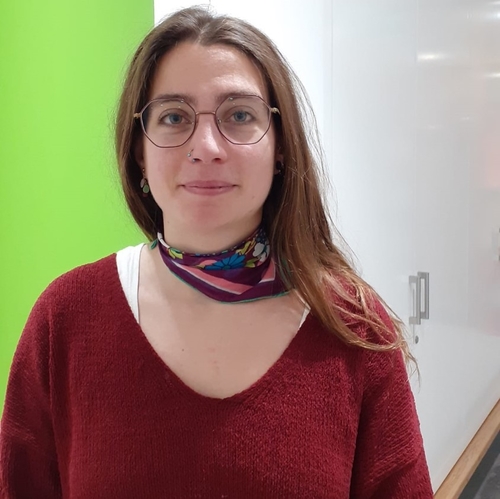
Beatriz Casares Fernández, PhD student
Current Project
Understanding the relation between the micro and macro scale interfacial strength in natural fibre composite materials
Project description
The widespread use of synthetic fibre composite materials has brought many benefits to engineering and energy development, but also many challenges. One of the latter is the environmental impact that these materials have when coming to the end of their life cycle. Developing new composite materials using natural fibres in combination with biodegradable matrices is one of the steps forward in order to achieve further development without compromising the future of our planet.
Understanding the interaction between the natural fibres with the matrix at the interface plays a key role to enhance the mechanical properties of natural-fibre composites. On one hand, tests like short beam strength or V-notched shear use specimens in order to obtain the shear properties at a macro scale level. On the other hand, the microbond test is used to measure the interfacial shear strength in an individual fibre-microdroplet system. Understanding how the results from both worlds connect and explain the interface behaviour using finite element analysis modelling will lead to finding a cost-effective coupling agent in the endeavour of pushing natural fibres to their limits.
This is a project funded by the Royal Academy of Engineering in collaboration with the National University of Colombia and Compañía de Empaques S.A. The study of the interface of fique fibre along with different thermoplastic matrices, focusing on biodegradable ones, plays a key role in the development of a new composite material reinforced with natural fibres. This new material, which aims to support structural loads, is being explored for small wind turbine blades for electrification of rural areas using local materials in South America. “
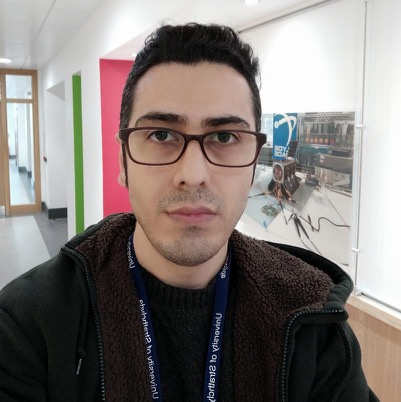
Hossein Rohani, PhD student
Current Project
Out-of-Autoclave Processing Development of Aerospace Carbon Fibre-Polymer Composites
Project description
Composite materials are faced with high market demands because of their superior properties, particularly in the aerospace industry. However, high time-and-energy consuming manufacturing processes, and consequently higher final product costs, are serious barriers to more widespread use in this area. Currently the autoclave process is a common and trusted manufacturing method because of void free and excellent quality of products. However, this method requires a relatively large amount of energy to prepare the pressurized and heated environment during the curing stage of carbon fibre reinforced polymers (CFRPs).
In this project, both experimental and numerical approaches will be applied to decrease the curing time and energy usage of a production cycle by studying epoxy curing kinetics and heat dissipation through the part. The need of using one-sided or double-sided heated moulding and various heating patterns, as well as effect of epoxy aging on thermoset properties, are included in the project plan. The insights gained will reduce CFRP product costs by improving energy efficiency of manufacture without sacrificing composite quality.
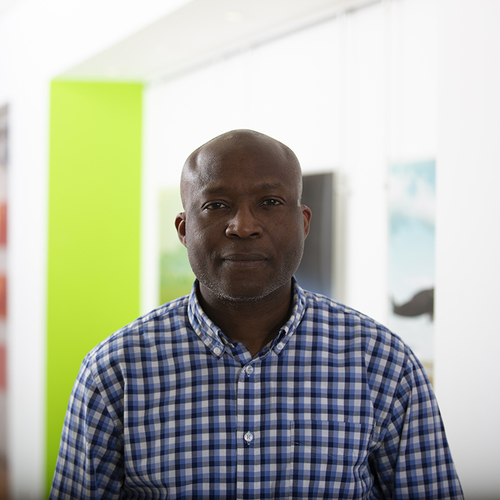
Damilola Aje, PhD student
Current Project
Developing Polymer Composite Structure for Processing Corrosive Fluids
Project description
Despite the fact that polymer composites have been extensively used in various chemical-related applications (e.g. tanks and pipes), long-term resistance against hot concentrated chemicals still remains extremely challenging for most polymer composites today. Composite design for this type of applications can be further complicated when the composite structure is going to be used to process chemical fluids such as rotatory propellers in engineering pumps. As a result, fluid-structure interaction needs to be investigated for composite design under coupled thermo-chemical environment.
This project is aimed to develop a novel design process and manufacturing route to producing corrosion-resistant composite structure for controlling chemical fluids such as sulphuric and phosphoric acids.
The key challenges that will be addressed in this project involve:
- Material selection and characterisation for chemical resistance at elevated temperatures.
- Composite structure design for fluids control using FEA.
- Component prototyping using 3D printing for complex geometry.
Damilola's background
Damilola has been in the oil and gas industry as a Senior Design Engineer prior to joining the PhD programme. He has first-hand experience in the design and assessment of piping systems, having started his engineering career as a Piping Systems Engineer in 2002. He has eighteen years’ industrial experience and knowledge in piping design, pipework assessments and Pipe stress analysis and has worked across many engineering design companies both in Africa and in the United Kingdom.
He is a corporate member of the Institution of Mechanical Engineers (IMechE) and is also a Chartered Engineer with IMechE.
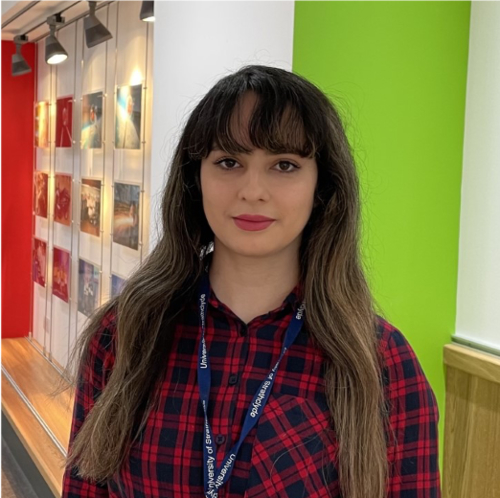
Roya Akrami, PhD student
Current Project
Investigating fibre-matrix interface and developing improved sizing for glass fibre-matrix bonding
Project description
Glass fibre products account for more than 95% of fibre reinforcements used in high performance and light-weight composite materials. Possibly the most critical component involved in the manufacture of glass fibres and their composites is the fibre sizing. The formulation and implementation of sizing is the key for a cost-effective production, processibility and optimized performance of glass fibre composites.
The project aims to work on the development of novel sizings for glass fibre reinforced composites with improved performance and sustainability. Sizing formulation is being investigated and characterised for fibre manufacturability, fibre performance, and fibre-matrix interfacial properties. This new material may have applications in different sectors including aerospace panel, wind turbine blades, and automotive parts.
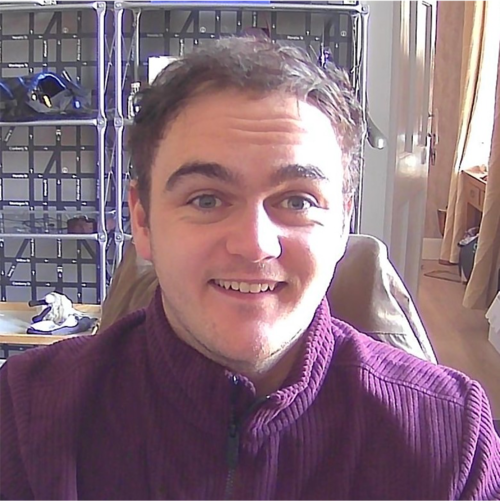
Andrew Carlin, PhD student
Current Project
Re-shaping fibre-reinforced composites: non-circular glass fibres for enhanced composite properties
Project description
The ongoing desire to lightweight structures for cost and environmental factors has required continuous innovation in glass fibre production and their composites. Innovation has typically come in the form of sizing and composition developments. However, developments in these areas are considered to be high up on their development S-curves and thus innovation is required elsewhere. Changing of the fibre cross-section offers both an opportunity to improve composite performance and add an additional layer of design.
The aim of this project is to characterise non-circular fibres already available on the market and develop design considerations for new products. Through multi-level characterisation an understanding of the origins of improvements will be investigated. Simultaneously, questions will be asked of the status quo and of models established in the past 100 years of fibreglass development. This requires a holistic approach with testing at the fibre, interface and laminate level combined with modelling work. Collaboration with Nippon Electric Glass and RWTH Aachen adds additional technical expertise and capability to the project.
With improvements spanning a broad range of properties, new non-circular glass fibre products could be utilised across multiple sectors with different design requirements and to provide robust solutions in areas previously not considered.
Andrew's background
Andrew is a recent graduate from the Mechanical & Aerospace department at Strathclyde. His prior industrial experience spans from building composite wind turbines in rural Peru to internships as a Fire Engineer in the consultancy sector. Andrew spent a year in industry at the National Composites Centre, developing insight into the complexities of composite R&D across a broad range of production processes and sectors, in collaboration with different companies from SMEs to multinationals. Driven by continuous improvement, he wants to see the development of more efficient materials and processes to cut back waste and our impact on the environment.
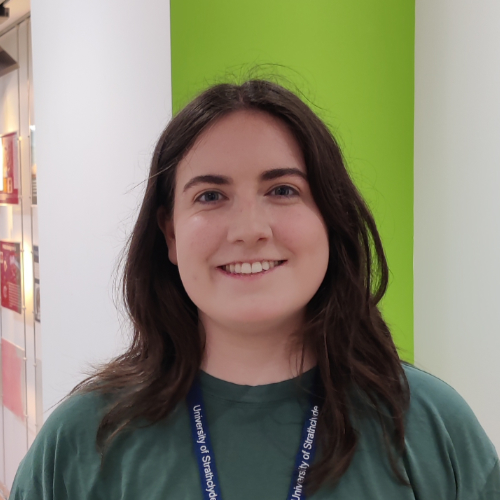
Beth Malone, PhD Student
Current Project
Advancing the understanding of the composite fibre-matrix interface through the development of automated mechanical testing
Project Description
Traditionally, the interfacial shear strength has been measured by means of manually operated single fibre tests, such as the microbond, pull-out and fragmentation tests. Each test applies a load to the fibre-matrix interface, allowing a measurement of the shear strength to be taken, providing scope for the impact of factors such as fibre coatings and environmental factors to be studied. The primary setback experienced in interface testing is the lack of standardisation, resulting in research groups having different methods and procedures for each test.
The optimisation of composite materials relies on the fundamental understanding of the interface, making the need for a standardised interface test vital. Fundamental study into the relationship between sample geometries and the respective fundamental math connected to them will be conducted, providing a basis on which to develop an analytical model suitable for the developed test. Furthermore, investigation into the contribution of residual stress to the interface strength will be carried out. The culmination of the project will be the development of a novel automated interface test system, which will allow for standard testing of the interface as well as fatigue testing.
This project is funded by Dia-Stron Limited, a market leader in the development of single filament testing instruments. Initial development and automation of Dia-Stron’s first generation microbond system (LEX820 IFSS) will form the basis for development of the final automated interface test system.
Beth's background
Beth graduated with a master’s degree in mechanical engineering with aeronautics from the University of Strathclyde in June 2023, and went on to join the group in August 2023. During her final two years of study, she completed research projects investigating the effect of manufacturing process and voids on the mechanical properties on carbon fibre laminates, using experimental and computational techniques. With her design experience developed through projects completed in her undergraduate classes, she looks forward to the challenge of designing a new micromechanical test system whilst factoring in the fundamental knowledge of the composite interface developed throughout the course of this project.

Paul Nixon, PhD Student
Current Project
An Investigation of the Fibre-Matrix Interface of Laser Processed Composite Materials
Project Description
Carbon fibre reinforced polymer composites have seen consistent growth in their usage as an
aerospace material over the past several decades. Despite this, there remain significant gaps in our knowledge and understanding of the micro-mechanical parameters that govern the structure-property relationships within these materials.
There has been no investigation into how the laser perforation of a composite material affects the fibre-matrix interface of the material locally, or the extent to which this influences the overall mechanical properties of the bulk material. There has also been no investigation into the thru-life environmental and fatigue properties of a laser perforated composite material. Understanding these fundamental characteristics is central to future use of laser perforated composites. In partnership with CAV-Systems, an industry leader in laser technology for aircraft ice protection and hybrid laminar flow control systems, my project aims to conduct fundamental research to answer these key questions.
Paul's background
Paul graduated from Strathclyde with a MEng in Mechanical and Aerospace Engineering in 2023. His interest in composite materials research was evident in his Masters year project, which explored the mechanical properties of various fibre reinforcements. The project had a specific focus on out-of-autoclave manufacturing methods, such as resin transfer moulding, which are gaining traction in the aerospace sector for their efficiency and reduced environmental impact. Building on this foundation, Paul has embarked on his PhD journey to further explore the field of advanced composite materials for the aerospace sector.

Lewis Kelly, PhD Student
Current Project
Investigation of the fibre-matrix interface for glass fibre and carbon fibre composites exposed to cryogenic loading and fatigue conditions
Project Description
With multiple sectors currently evaluating the use of liquid hydrogen as a key future energy source there is significant need to establish rational design rules for the pressurised vessels that will be used to store liquid hydrogen safely. These vessels, manufactured using composite materials, will be exposed to long-term adverse environmental conditions that have not yet been fully investigated. The effect of cryogenic cycling on the fundamental fibre-matrix performance of a composite material is an unaddressed and critical parameter in the long-term structural performance of liquid hydrogen pressurised vessels.
This project aims to understand and quantify the fibre-matrix interface for current generation resin and fibre combinations, utilised in liquid hydrogen pressurised vessels. Research will span investigating the effects on the interface whilst at cryogenic temperatures, as well as the effects of repeated cryogenic cycling on the fibre-matrix interface. Funding for this project is provided by the Engineering and Physical Sciences Research Council.
Lewis's background
Driven by his pursuit of knowledge and innovation, Lewis joined the group in 2023 after graduating with a master’s degree in chemistry from the University of Strathclyde. During his final two years of study, he collaborated with the polymer degradation group in which time he investigated photodegradation and thermo-oxidative degradation of thermoplastic polymers under the guidance of Professor John Liggat. This hands-on experience provided him with a solid foundation in polymer chemistry, specifically in assessing material behaviour and degradation mechanisms under harsh conditions. With his expertise, Lewis is well-equipped to deepen the understanding of the effects on the fibre-matrix interface under cryogenic loading and fatigue conditions.

Innes McKay, PhD Student
Current Project
Innovative manufacture of sustainable composites
Project Description
Recently, the composites sector has recognised the need for a new generation of renewable composite materials, and research into the use of sustainably derived polymeric compounds and natural fibre reinforcements has dramatically increased. Flax fibre is one of the most promising natural fibres due to its low environmental impact and high reported specific mechanical properties. However, there are several key shortcomings associated with flax fibre that currently prevent its widespread use as reinforcing material, including its poor compatibility with polymer matrices, moisture absorption behaviour, and flammability. These limitations must be addressed if flax fibre is to be considered a viable alternative to glass fibres as a reinforcing material.
This project aims to enhance the performance of bio-composites through the use of novel fibre treatments. The impact of treatment methodology on the mechanical, chemical, and thermal properties of flax fibre will be examined. Bio-composites will then be developed and characterised utilising treated fibres and a bio-based thermosetting/thermoplastic polymer matrix. Treatment parameters will be optimised to enhance the mechanical performance, moisture absorption behaviour, and thermal stability of resultant bio-composites. In doing so, this project will address the current shortcomings of natural fibre bio-composites, improving their functionality and expanding the scope of potential applications.

Ertug Ihsan Tanisan, PhD Student
Current Project
3D-Printing of polymer and polymer composites for harsh environment
Project Description
Ertug is a fully funded PhD student from the National Education Ministry of the Turkish Government whose research focuses on investigating the slurry erosion behaviour of 3D-printed (fused deposition modelling) polymers and polymer composites used for application areas are exposed to slurry erosion effects such as slurry transport systems, tidal/wind turbines, aircraft and vehicles.
Ertug's background
After completing his bachelor's and master's degrees in materials science and engineering in Turkiye, he worked as a senior engineer in a company that produces traditional ceramics for 4 years. In line with his education and sector knowledge, he has gained experience in additive manufacturing, traditional/advanced ceramics production and their characterisation.

Johnattan Vargas, PhD Student
Current Project
Using thermally recycled glass fibres from wind turbine blades at the end of its life cycle to be used as reinforcement in compound products
Project Description
Wind turbine blades usually operate safely for 20 to 25 years before to be changed and discarded; however, traditional disposal methods such as landfilling represent a high cost and it is not generating added value to that industrial chain. Despite the complexity of recycling glass fibres from thermoset resin – based polymeric composite materials, various promising approaches have been proposed and implemented. Taking advantage of the ACG expertise and in-house facilities, this PhD project aims to employ thermal recycling processes to obtain the fibres from wind turbine blades at the end of its life cycle.
To use the recycled glass fibres as reinforcement to manufacture compound products requires a thorough understanding of how the recycling process affects the mechanical and physical characteristics. Additionally, since wind turbine blade waste is typically chopped prior to recycling, the length of the fibres becomes a crucial parameter. This project will focus on evaluating these characteristics to optimize the performance of the recycled fibres as reinforcement in compound products.
Johnattan's background
Johnattan is an Industrial Design Engineer with a master’s degree in Engineering – Materials and Processes. His master’s thesis focused on polymeric composite materials reinforced with fique fibres, a natural fibre widely used in Colombia for manufacturing ropes and sacks. The main aim of the project was to understand and enhance the adhesion at the interface between the fique fibres and a polyester resin.
ACG alumni
Dr Wichain Chailad
Project: Investigation of slurry erosion behaviour of rubbers and rubber composites. Now at Rajamangala University of Technology Thanyaburi in Pathum Thani, Thailand.
Dr Ashlee Espinoza
Project: Additively manufactured polymers and polymer composites for minerals processing technology. Now the University of Strathclyde working with the Weir Group
Dr Miguel Ubago Torres
Project: Additive layers to suppress delamination in composite laminates. Now at iLosta (Crack Map), Glasgow.
Dr Shima Dayarian
Project: Investigation of novel methods for manufacturing polyimide aerogel stock shape. Now at Mersen.
Dr Georgios Xypolias
Project:The environmental resistance of glass fibre vinyl ester composites and their interface for use in structural applications. Now at GAIKER Technology Centre in Madrid, Spain.
Dr Kaibao Wang
Project: Novel development of eco-friendly porous thermal insulation materials and the application.
Dr Mariusz Kucharek
Project: Investigation of Key Challenges Facing Aerogel Composites Development Through Multiscale Approach. Now at Leyton UK in Glasgow.
Dr Andrew Webley
Project: Development of fibre and particulate filled aerogel composites for subsea pipeline applications.
Dr Sairah Bashir
Project: Development of a cost-effective chemical approach to regenerate surface properties of thermally recycled glass fibre for reuse in composites. Now at Lightweight Manufacturing Centre, part of the National Manufacturing Institute Scotland in Glasgow.
Dr Kyle Pender
Project: Recycling, regenerating and reusing reinforcement glass fibres. Now at the National Composites Centre, Bristol.
Dr Ross Minty
Project: The Influence of Matrix Stoichiometry on Interfacial Adhesion in Composites for Wind Turbine Applications. Previously at Far Composites in Nottingham, now returned to the ACG as Lecturer in Composites Sustainability and Reinforcement.
Dr Peter Jenkins
Project: Investigation of the Strength Loss of Heat Treated Glass Fibre; DACOMAT. Now undertaking a KTP with the University of Strathclyde.
Dr Ulf Nagel
Project: Towards Affordable, Closed-Loop Recyclable Future Low Carbon Vehicle Structures – (TARF-LCV). Now at Brandenburger Group.
Dr José-Luis Rudeiros Fernández
Project: Improving the Impact Performance of Injection Mouldable Natural Fibres Polyolefin Compounds for Lightweight Automotive Applications. Now at CERN in Geneva.
Dr Eduardo Sáez-Rodríguez
Project: Regenerated Composite Value Reinforcement (ReCoVeR). Now at Glencore Zinc.
Kerrie Downes
Project: Interface in glass fibre reinforced polyamide composites (with 3B – The Fibreglass Company). Now at Aggreko in Glasgow.
Dr Chih-Chuan Kao
Project: Regenerated Composite Value Reinforcement (ReCoVeR). Now at Industrial Technology Research Institute in Taiwan.
Dr R.T. Durai Prabhakaran
Project: Towards Affordable, Closed-Loop Recyclable Future Low Carbon Vehicle Structures – (TARF-LCV). Now an Associate Professor at Indian Institute of Technology Jammu.
Dr Fiona Cullinane
Project: Characterisation of Environmentally Friendly Fibres for Composites. Now at Scottish Power.
Susan Roch
Project: Development of a meso-scale test for carbon-fibre reinforced composites. Now at Subsea 7.
Discover more about some of our exciting research projects
Advances in polymer aerogel insulation
A recent collaboration with Blueshift Materials has led to exciting advances in polymer aerogel composite blankets